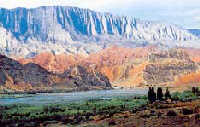| |
Aksu Region
( 2005-09-13 )
 The Aksu region is located in the west of Northwest China'sXinjiangUygur Autonomous Region, on the northern edge on the Tarim Basin and to the south of the Tianshan Mountains. It adjoins the Central Asian countries of Kyrgyzstan and Kazakhstan to the west and the Taklimakan Desert to the south. The Aksu region is located in the west of Northwest China'sXinjiangUygur Autonomous Region, on the northern edge on the Tarim Basin and to the south of the Tianshan Mountains. It adjoins the Central Asian countries of Kyrgyzstan and Kazakhstan to the west and the Taklimakan Desert to the south.
Under its administration are eight counties and one city, with a population of 2.14 million (including an ethnic minority population of 1.55 million). Aksu city, the location of the administrative agency, is 995 and 1,126 kilometers away from Urumqi based on highway and railway distance respectively.
The Aksu region has a warm-temperate continental arid climate. The region has 1,298 glaciers, with a total area of 4,098 square meters and a water storage capacity of some 2,154 hundred million cubic meters, supplying water to 60 small or big rivers andsprings. The main water systems are the Aksu, Weigan, Tarim, Tailan, and Kuqa rivers. The total area of the lakes is 6,815 hectares. The annual surface-water runoff is 129.4 hundred million cubic meters.
The natural pastureland is 3,539,100 hectares, with an available area of 3,335,400 hectares. The forest area is 581,900 hectares, with a coverage rate of 4.4 percent.
The wild medicinal plants number over 100, typified by Ephedra sinica, Bupleurum, Paeonia lactiflora pallas, Condonopsis pilosula, Angelica, Chinese yam, wolfberry, licorice, Lop hemp, Fritillaria thun-bergli Safflower, and Saussurea involucrate.
The species of wild animals number more than 300, represented by the brown bear,snow leopard, red deer,white stork, white crane, black and white shoulder vulture, swan, and snow cock.
The region is rich in mineral resources, such as iron, coal, uranium, copper, phosphorus, petroleum, natural gas, salt, granite and marble, and so on.
Aksu was an ancient Buddhist kingdom located on the route of theSilk Roadthat ran along the northern edge of the Taklamakan desert in the Tarim Basin. The famous Tang-Dynasty (618-907) monk pilgrimXuanzang(on who the Journey to the West is based) recorded that there were tens of Buddhist monasteries in the kingdom and over 1,000 monks.
There are many tourist attractions, such as the Kezil Thousand-Buddha Caves, the Kizilgah Beacon Tower, the ruins of Qiuci, the Kuche Mosque, andTarim River. Famed for the ancient Qiuci dances with musical accompaniment, Aksu is named the "home of song and dance."
|
|

